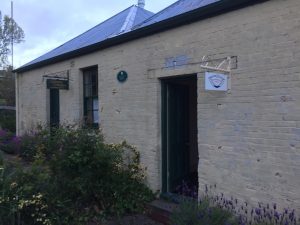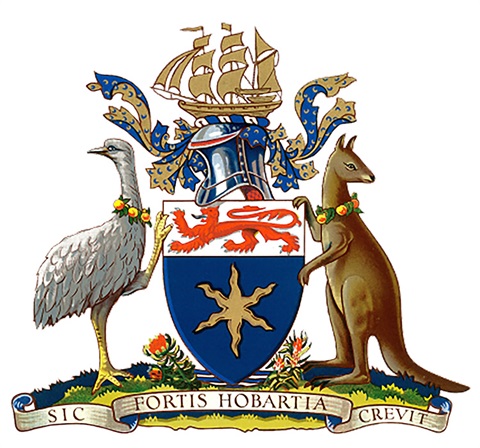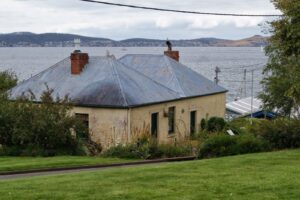THE MARINERS' COTTAGES
42 Napoleon Street Battery Point Tasmania
These cottages are the oldest remaining buildings on the site of the ship building yards in Napoleon Street. They are brick, English bond, three bricks thick. In some places the English bond is not totally consistent as there is a row of headers followed by 4 rows of stretchers generally but in some instances, there are 6 rows of stretchers. Typically, this is known as English Garden Bond. The internal walls of the top cottage are of timber, with random width tongue and groove boards, whereas the bottom cottage internal walls are plaster rendered. The ceilings in both cottages are tongue and groove boards. In the roof space are the battens to which shingles were once attached.
Other architectural features that provide evidence of the buildings colonial origins are the 8” (203 mm) wide hand hewn, Huon Pine floor-boards, in what would have been the main room of the lower cottage. The other floor-boards, also hand hewn, are 5” (127 mm) wide. In some places there are Huon Pine timber lintels. There is also a very early door handle on the door between the main room and kitchen in the riverside cottage [per David Moell, colonial building restorer]. Similar door handles can be found in Stephenville, the former home of Alfred Stephen, Solicitor General for Tasmania (later Chief Justice of NSW), built in 1825.
In recent years the Council undertook remedial works to the roof, gutters and drainage around the fittings. The paint coating was chemically stripped off the external brickwork. On finding the good condition of the external brick surface, Council decided to not apply a replacement coating.
The picket fence surrounding the cottages was erected in 1987 and the garden planted by TAFE horticulture students. In the south east corner just outside the picket fence is a rose bush believed to be "Sunny South" hybridised in 1918. It could well be the oldest rose in Battery Point.
The cottages were built on a portion of the 90 acres of land originally granted to William Sorell, Esquire, third Lieutenant-Governor of Van Diemen's Land. These 90 acres were sold in 1824 to William Kermode for £600; in 1833 the block on which the Mariners' Cottages stand was bought by James Kelly, Master Mariner of Hobart Town. He leased the site in 1839 to John Watson, shipbuilder, who bought it from Kelly in 1843 for £736 19s 4d.
The conveyance mentions "land and buildings", and it is believed that John Watson had already built the lower cottage before purchasing the land, upon which he had also already built his famous shipyard. On one survey, the lower cottage is marked as a store, and it is believed that John Watson used it to securely store valuable timber and fittings for shipbuilding. There were also a blacksmith's shop and a carpenter's shop nearby (long since demolished).
John Watson arrived from England in 1831, and was master shipwright of the shipbuilding yard at Port Arthur in 1834-36. He set up his own business on the site in 1839 and among the ships he built were the famous "Flying Squadron" — Flying Squirrel, Flying Fish, Flying Childers (the ship on the crest of the Hobart City Council) and Flying Fox. Others were the Sisters, Panama, Fair Tasmania, Free Trader, Swordfish and Southern Cross. The barque Runnymede, a famous whaler which featured on the cover of the 1988 Hobart phone book, was another Watson-built ship.
Following Watson’s insolvency, in 1856 the property was offered for sale:
“That Extensive, valuable and Important Property known as Mr Watson’s Ship-yard with cottages, workshops, stores, jetty and wharf etc. etc. which will be divided into convenient and judiciously arranged lots.”
The whole property was sold to Duncan McPherson for £4000. The shipyard was run by J Lucas and R A Jeffrey and later, in the 1880s, by Messrs Tilly and Williams.
After the shipyard was sold, the cottages were leased to various tenants for more than a century. Some very poor additions during the early 20th century, rising damp and water spillage from the roadway all caused considerable damage, especially in the top cottage.
In 1983 the Hobart City Council, as new owners, leased the cottages to the National Trust of Australia (Battery Point Group) in return for a peppercorn rent. The Trust agreed to restore the cottages and spent more than $20,000 on the restoration with members of the Cruising Yacht Club of Tasmania Inc. doing most of the work. The CYCT volunteer work included removing various external sheds, the construction of an internal toilet and shower and refurbishment of the kitchen. Likewise, the Wooden Boat Guild of Tasmania Inc. carried out many hours of basic maintenance during the period the Guild shared the lower cottage with the CYCT.
The CYCT together with the Guild were sub-tenants of the National Trust for the lower cottage until their lease with the Trust was terminated in 2013. For the period 1983 to 2013 the top (northern) cottage was occupied by an antique dealer and one marine-oriented business as joint occupants.
In June 2016 the Wooden Boat Guild of Tasmania Inc. entered into a 5-year lease for both cottages with the Hobart City Council, which was renewed in 2022. The cottages provide meeting and work-rooms, library and store for the Guild.
The Cottages have a long connection with Tasmania's shipbuilding history. The presence and activities of the Wooden Boat Guild of Tasmania Inc. assists in continuing this connection.
(Adapted by the WBGT from the original HCC signage.)
For more information and photographs, see: https://ontheconvicttrail.blogspot.com/search?q=mariners+cottages
Download a copy of our brochure here




